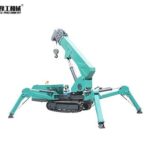Compact electric forklift is a battery-powered material handling vehicle designed for maneuverability in confined spaces. Unlike larger, bulkier forklifts, these machines prioritize space efficiency without compromising lifting capacity or performance. They are ideal for indoor operations such as narrow aisles, storage racks, and loading docks, where traditional forklifts may struggle to operate effectively.
Components of Compact Electric Forklift
- Electric Motor: Powered by rechargeable batteries, eliminating emissions and reducing noise.
- Compact Chassis: A streamlined design for navigating tight spaces.
- Ergonomic Controls: User-friendly interfaces to enhance operator comfort and productivity.
- Lifting Mechanism: Robust forks and hydraulic systems capable of handling loads up to several tons.
Advantages of Small Electric Forklifts
- Environmental Sustainability
As global industries shift toward greener practices, compact electric forklifts offer a significant advantage: zero emissions. Unlike diesel or propane models, they produce no exhaust fumes, improving air quality in indoor environments. This aligns with corporate sustainability goals and regulatory requirements, particularly in sectors like food processing, pharmaceuticals, and electronics manufacturing. - Cost Efficiency
While the upfront cost of an electric forklift may be higher, long-term savings are substantial. Electricity is cheaper than fossil fuels, and maintenance costs are lower due to fewer moving parts. Additionally, electric models avoid expenses related to fuel storage and emissions testing. - Enhanced Maneuverability
The compact design allows these forklifts to operate efficiently in narrow aisles and crowded workspaces. Features like rear-wheel steering and tight turning radii enable precise movements, reducing the risk of product damage and workplace accidents. - Quiet Operation
Electric motors generate minimal noise compared to internal combustion engines. This is critical in noise-sensitive environments such as hospitals, libraries, or late-night retail operations. - Improved Operator Comfort
Modern compact electric forklifts prioritize ergonomics with adjustable seats, intuitive controls, and vibration reduction. Operators experience less fatigue, leading to higher productivity and job satisfaction.
Electric Sit Down Forklift Characteristics
Electric Power:
The compact electric forklift utilizes batteries, making them cleaner and quieter than traditional internal combustion engine forklifts.
This is particularly advantageous for indoor applications where exhaust fumes are a concern.
Compact Design:
They are built with smaller dimensions and tighter turning radii, enabling them to navigate narrow aisles and tight corners.
This makes them ideal for warehouses, retail spaces, and other areas with limited space.
Maneuverability:
Their design prioritizes maneuverability, often featuring features like three-wheel configurations or specialized steering systems.
Indoor Use:
Electric forklifts are generally preferred for indoor use due to their lack of emissions and quiet operation.
Common Applications
Warehouses: Efficiently moving pallets and goods in storage areas.
Retail Stores: Stocking shelves and managing inventory in confined retail spaces.
Manufacturing Facilities: Transporting materials and components within production areas.
Distribution Centers: Loading and unloading trucks and organizing inventory.


